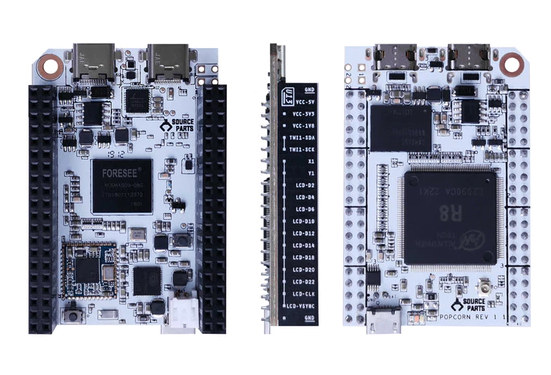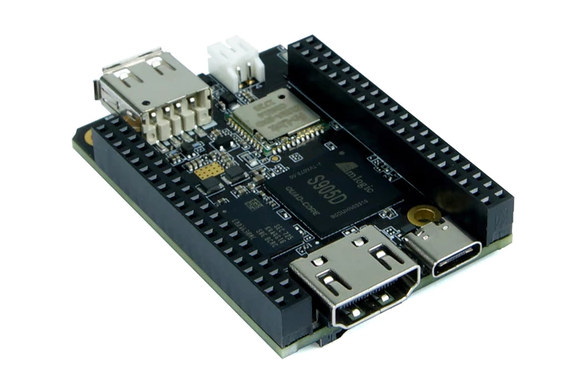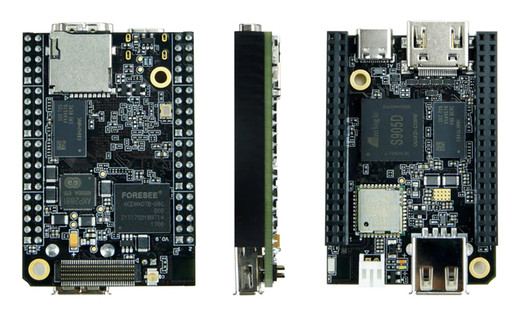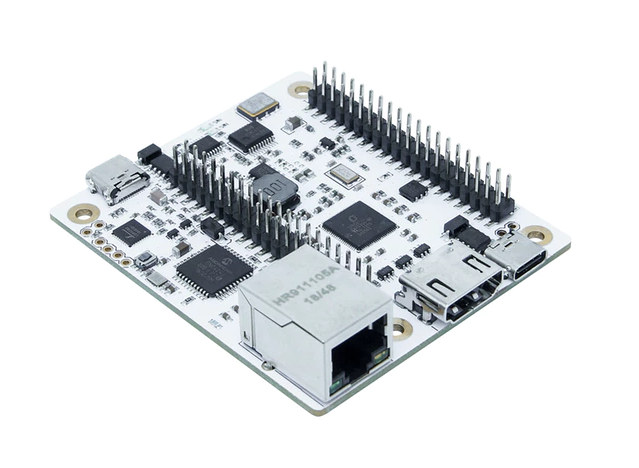C.H.I.P was a $9 Linux computer launched in 2015 by Next Things Co., and followed by the $16 C.H.I.P Pro in 2016. Sadly the company eventually encountered financial troubles and had to fold last year. But the design was open source hardware, Source Parts managed to get hold of several original Allwinner GR8 systems-in-package, and in April we reported that they sold Kettlepop, a limited edition of a CHIP Pro derivative fitted with 8GB eMMC flash.

Source Parts is now back with three CHIP lookalikes:
- Popcorn Original based on Allwinner R8/A13 Arm Cortex-A8 processor with 512MB RAM, and 32GB eMMC flash and 100% software compatible with the original C.H.I.P computer
- Super Popcorn Computer powered by Amlogic S905D quad-core Cortex-A53 processor
- Super ‘8’ Popcorn Computer powered by Amlogic S912 octa-core Cortex-A53 processor

Popcorn Original is basically the same as C.H.I.P board except for the 32GB eMMC flash storage replacing the 4GB NAND NAND on the original board, as well as a USB-C port instead of micro USB. So let’s focus on the new Super Popcorn boards that share most of the same specifications except for the SoC:
- SoC
- Super Popcorn – Amlogic S905D quad-core Cortex-A53 processor @ 1.5 GHz with Mali-450 MP3 GPU
- Super ‘8’ Popcorn – Amlogic S912 octa-core Cortex-A53 processor @ 1.5 / 1.0 GHz with Mali-T820 MP3 GPU
- System Memory – 1GB DDR4
- Storage – 32GB eMMC flash, microSD card slot
- Video Output – HDMI 2.0b up to 4K @ 60 Hz
- Camera I/F – DVP camera input
- Connectivity – WiFi 4 802.11b/g/n + Bluetooth 4.2
- USB – 1x USB-A host port, 1x USB 2.0 OTG Type-C port
- Expansion – CHIP headers with up to 62 GPIO, RGB LCD, 1-Wire, UART, I2C, SPI, PWM Output, digital audio output and input, and analog stereo audio
- Power Supply – 5V via USB-C port; battery charging circuit and 2-pin header for battery
- Dimensions – 60 x 40 mm
 The company also made a companion baseboard for their Popcorn Original board, and compatible with C.H.I.P board as well, as but not the Super Popcorn Computer boards since they already have HDMI output onboard.
The company also made a companion baseboard for their Popcorn Original board, and compatible with C.H.I.P board as well, as but not the Super Popcorn Computer boards since they already have HDMI output onboard.
Stovetop baseboard exposes 10/100M Ethernet, HDMI output, USB-C power input and a USB-C serial debug connector.
 It might have been good to make the board a little wider and add two extra rows of headers, as now when you plug CHIP or Popcorn Original board, you basically lose access to the I/O header.
It might have been good to make the board a little wider and add two extra rows of headers, as now when you plug CHIP or Popcorn Original board, you basically lose access to the I/O header.
There’s limited information about software support, but the original board benefits from C.H.I.P ecosystem, and it’s clear all boards will run Linux. The company is also developing web-based and offline cross-platform flashing, cloning, and backup tools.
Source Parts is making all boards available on Kickstarter with a fairly high funding target of $250,000. Rewards start at $39 for Stovetop if you already own a CHIP board, $49 for a PopCorn Original board, $69 for Super Popcorn Computer, and $89 for Super ‘8’ Popcorn. All boards ships with accessories such as a USB-C to USB-A cable and an HDMI cable. You’ll also need to add $8 to $20 for shipping depending on rewards and country of destination. That makes the boards quite pricey for the specifications, but at least if they manage to reach $250,000, they will probably not have financial issues and will deliver the goods on November 2019 or soon after.
Thanks to Raylynn for the tip.

Jean-Luc started CNX Software in 2010 as a part-time endeavor, before quitting his job as a software engineering manager, and starting to write daily news, and reviews full time later in 2011.
Support CNX Software! Donate via cryptocurrencies, become a Patron on Patreon, or purchase goods on Amazon or Aliexpress




